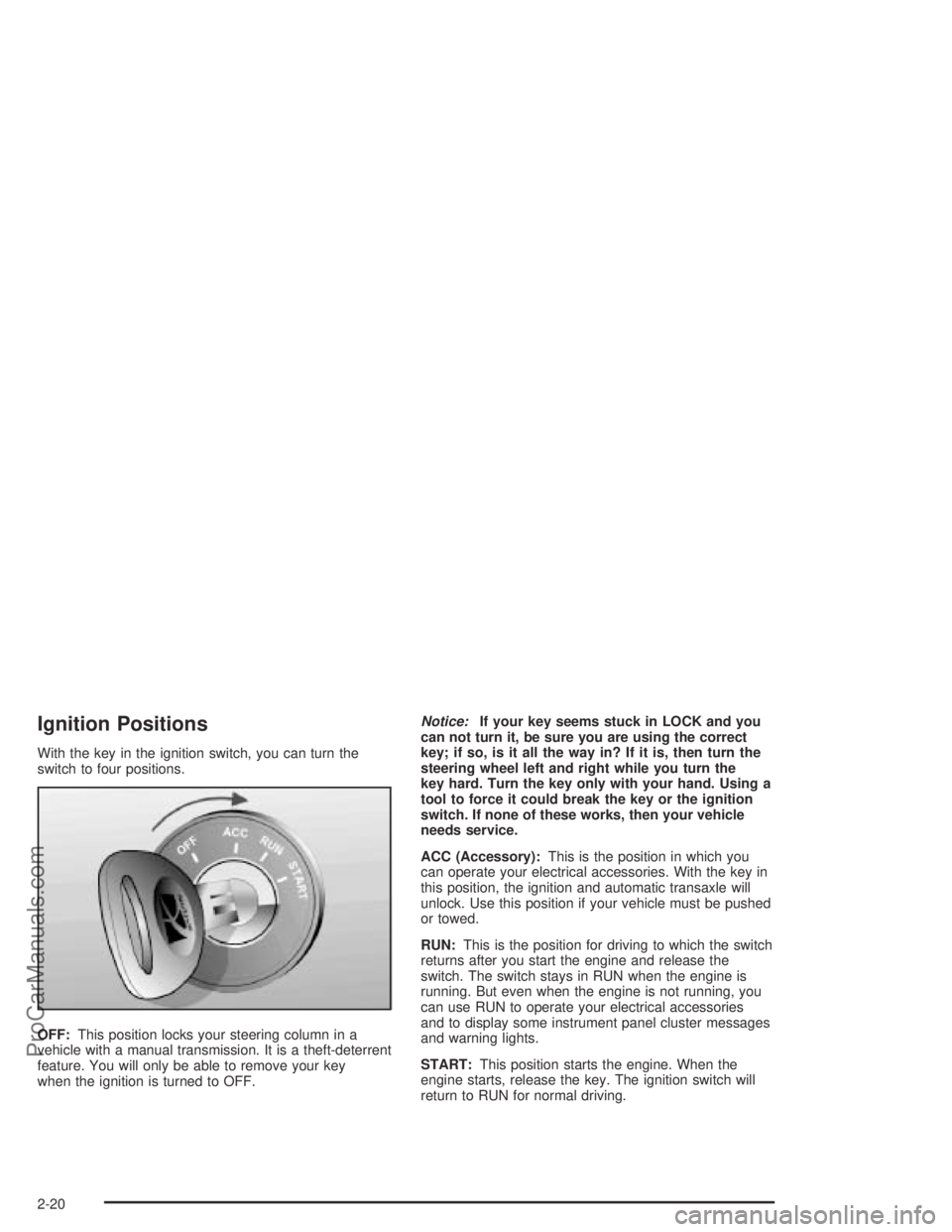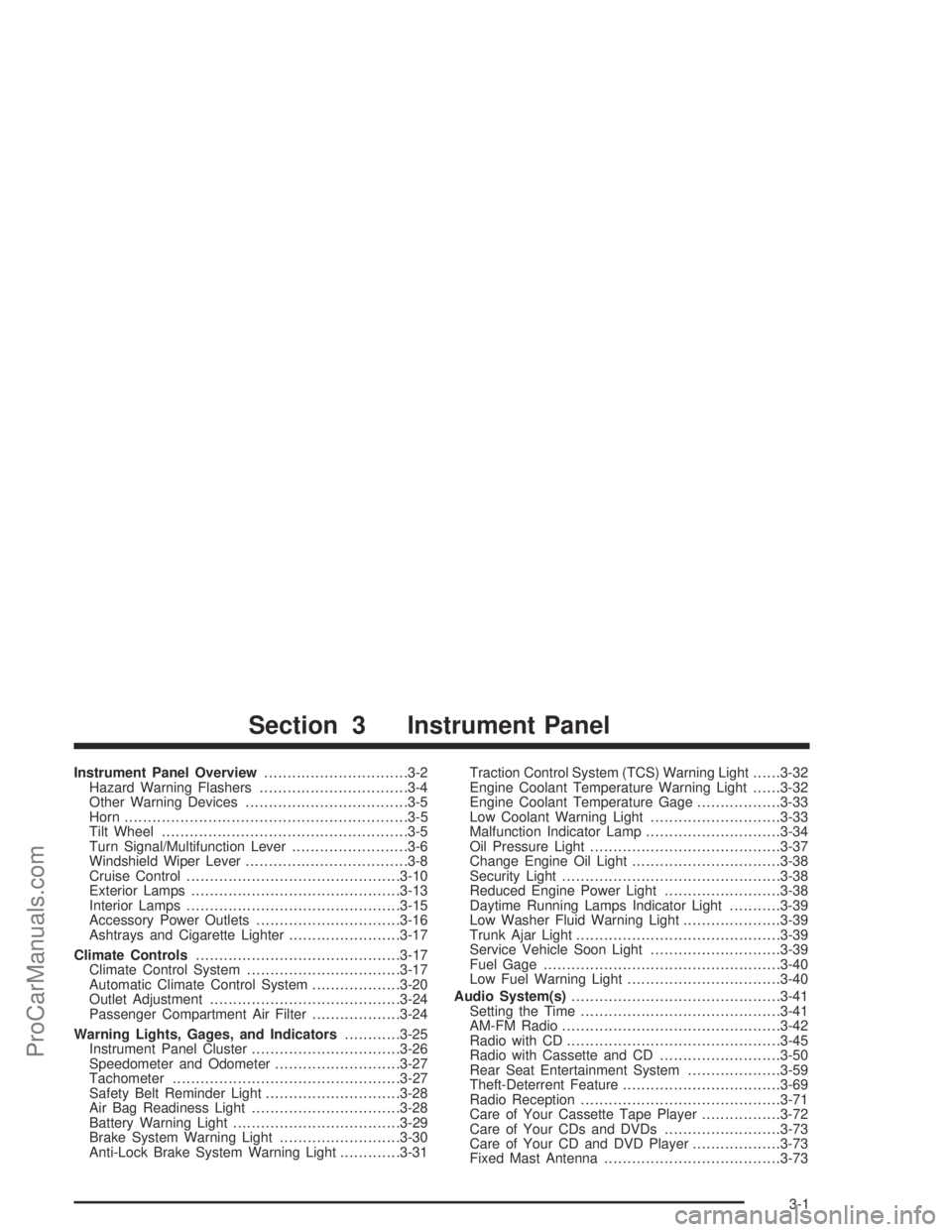instrument cluster SATURN L-SERIES 2004 Owners Manual
[x] Cancel search | Manufacturer: SATURN, Model Year: 2004, Model line: L-SERIES, Model: SATURN L-SERIES 2004Pages: 386, PDF Size: 2.89 MB
Page 100 of 386

Ignition Positions
With the key in the ignition switch, you can turn the
switch to four positions.
OFF:This position locks your steering column in a
vehicle with a manual transmission. It is a theft-deterrent
feature. You will only be able to remove your key
when the ignition is turned to OFF.Notice:If your key seems stuck in LOCK and you
can not turn it, be sure you are using the correct
key; if so, is it all the way in? If it is, then turn the
steering wheel left and right while you turn the
key hard. Turn the key only with your hand. Using a
tool to force it could break the key or the ignition
switch. If none of these works, then your vehicle
needs service.
ACC (Accessory):This is the position in which you
can operate your electrical accessories. With the key in
this position, the ignition and automatic transaxle will
unlock. Use this position if your vehicle must be pushed
or towed.
RUN:This is the position for driving to which the switch
returns after you start the engine and release the
switch. The switch stays in RUN when the engine is
running. But even when the engine is not running, you
can use RUN to operate your electrical accessories
and to display some instrument panel cluster messages
and warning lights.
START:This position starts the engine. When the
engine starts, release the key. The ignition switch will
return to RUN for normal driving.
2-20
ProCarManuals.com
Page 127 of 386

Instrument Panel Overview...............................3-2
Hazard Warning Flashers................................3-4
Other Warning Devices...................................3-5
Horn.............................................................3-5
Tilt Wheel.....................................................3-5
Turn Signal/Multifunction Lever.........................3-6
Windshield Wiper Lever...................................3-8
Cruise Control..............................................3-10
Exterior Lamps.............................................3-13
Interior Lamps..............................................3-15
Accessory Power Outlets...............................3-16
Ashtrays and Cigarette Lighter........................3-17
Climate Controls............................................3-17
Climate Control System.................................3-17
Automatic Climate Control System...................3-20
Outlet Adjustment.........................................3-24
Passenger Compartment Air Filter...................3-24
Warning Lights, Gages, and Indicators............3-25
Instrument Panel Cluster................................3-26
Speedometer and Odometer...........................3-27
Tachometer.................................................3-27
Safety Belt Reminder Light.............................3-28
Air Bag Readiness Light................................3-28
Battery Warning Light....................................3-29
Brake System Warning Light..........................3-30
Anti-Lock Brake System Warning Light.............3-31Traction Control System (TCS) Warning Light......3-32
Engine Coolant Temperature Warning Light......3-32
Engine Coolant Temperature Gage..................3-33
Low Coolant Warning Light............................3-33
Malfunction Indicator Lamp.............................3-34
Oil Pressure Light.........................................3-37
Change Engine Oil Light................................3-38
Security Light...............................................3-38
Reduced Engine Power Light.........................3-38
Daytime Running Lamps Indicator Light...........3-39
Low Washer Fluid Warning Light.....................3-39
Trunk Ajar Light............................................3-39
Service Vehicle Soon Light............................3-39
Fuel Gage...................................................3-40
Low Fuel Warning Light.................................3-40
Audio System(s).............................................3-41
Setting the Time...........................................3-41
AM-FM Radio...............................................3-42
Radio with CD..............................................3-45
Radio with Cassette and CD..........................3-50
Rear Seat Entertainment System....................3-59
Theft-Deterrent Feature..................................3-69
Radio Reception...........................................3-71
Care of Your Cassette Tape Player.................3-72
Care of Your CDs and DVDs.........................3-73
Care of Your CD and DVD Player...................3-73
Fixed Mast Antenna......................................3-73
Section 3 Instrument Panel
3-1
ProCarManuals.com
Page 129 of 386

The main components of the instrument panel are the
following:
A. Air Outlets. SeeOutlet Adjustment on page 3-24.
B. Turn Signal/Multifunction Lever. SeeTurn
Signal/Multifunction Lever on page 3-6.
C. Cruise Control (If Equipped). SeeCruise Control on
page 3-10.
D. Horn. SeeHorn on page 3-5.
E. Instrument Panel Cluster. SeeInstrument Panel
Cluster on page 3-26.
F. Windshield Wiper Lever. SeeWindshield Wiper
Lever on page 3-8.
G. Heated Seats (If Equipped). SeeHeated Seats on
page 1-5.
H. Fog Lamps (If Equipped). SeeInterior Lamps on
page 3-15.I. Hazard Warning Flasher Button. SeeHazard
Warning Flashers on page 3-4.
J. Traction Control. SeeTraction Control System (TCS)
Warning Light on page 3-32.
K. Audio System. SeeAudio System(s) on page 3-41.
L. Trunk Release Button/Dimmer Switch. See
Trunk/Liftgate on page 2-13/Interior Lamps on
page 3-15.
M. Hood Release. SeeHood Release on page 5-10.
N. Climate Control. SeeClimate Control System
on page 3-17.
O. Automatic Transaxle Shift Lever. SeeAutomatic
Transaxle Operation on page 2-23.
P. Power Windows. SeePower Windows on page 2-17.
Q. Glove Box. SeeGlove Box on page 2-41.
3-3
ProCarManuals.com
Page 132 of 386

Turn Signal/Multifunction Lever
The lever on the left side of the steering column
includes the following:
Turn and Lane-Change Signals
Headlamps
Headlamp High/Low-Beam Changer
Flash-to-Pass Feature
For additional information on the exterior lamps, see
Exterior Lamps on page 3-13.
Turn and Lane-Change Signals
The turn signal has two upward (for right) and two
downward (for left) positions. These positions allow you
to signal a turn or a lane change.
To signal a turn, move the lever all the way up or down.
When the turn is �nished, the lever will return
automatically.
An arrow on the instrument
panel cluster will �ash in
the direction of the
turn or lane change.
To signal a lane change, raise or lower the lever until
the arrow starts to �ash. Hold it there until you complete
the lane change. The lever will return by itself when
you release it.
As you signal a turn or a lane change, if the arrows
�ash rapidly, a signal bulb may be burned out and other
drivers won’t see your turn signal.
If a bulb is burned out, replace it to help avoid an
accident. If the arrows do not go on at all when you
signal a turn, check the fuse, seeFuses and Circuit
Breakers on page 5-92and for burned-out bulbs.
3-6
ProCarManuals.com
Page 133 of 386

Headlamp High/Low-Beam Changer
To change the headlamps from low beam to high or high
beam to low, pull the turn signal lever all the way
towards you. Then release it.
When the high beams are
on, this light on the
instrument panel cluster
will also be on.
Flash-to-Pass
This feature lets you use your high-beam headlamps to
signal a driver in front of you that you want to pass.
To use it, pull the turn signal/multifunction lever toward
you until the high-beam headlamps come on, then
release the lever to turn them off.
Headlamps
The exterior lamp control is located in the middle of the
turn signal/multifunction lever.
O(Exterior Lamp Control):Turn the control with this
symbol on it to operate the exterior lamps.The exterior lamp control has the following four
positions:
AUTO (Automatic):Turn the control to this position to
put the headlamps in automatic mode. AUTO mode
will turn the exterior lamps on and off depending upon
how much light is available outside of the vehicle.
;(Parking Lamps):Turn the control to this position
to turn on the parking lamps together with the
following:
Sidemarker Lamps
Taillamps
License Plate Lamps
Instrument Panel Lights
53(Headlamps):Turning the control to this
position turns on the headlamps, together with the
previously listed lamps and lights.
Lamps On Reminder
If you open the driver’s door with the ignition off and the
lamps on, you will hear a warning chime.
3-7
ProCarManuals.com
Page 152 of 386

Instrument Panel Cluster
The instrument cluster is designed to let you know at a glance how the vehicle is running. You will know how fast
you are going, about how much fuel you have used, and many other things you will need to know to drive safely and
economically.
3-26
ProCarManuals.com
Page 156 of 386

Brake System Warning Light
Your vehicle’s hydraulic brake system is divided into two
parts. If one part isn’t working, the other part can still
work and stop you. For good braking, though, you need
both parts working well.
If the brake system warning light comes on, there is a
brake problem. Have your brake system inspected
right away.
The BRAKE light is located
in the instrument panel
cluster.
This light should come on brie�y when you turn the
ignition key to RUN. If it doesn’t come on then, have it
�xed so it will be ready to warn you if there’s a
problem.
When the ignition is on, the BRAKE light will come on
when you set your parking brake. The light will stay on if
your parking brake doesn’t release fully.A chime will also sound if the parking brake is not fully
released and the vehicle is moving. If it stays on
after your parking brake is fully released, it means you
have a brake problem.
The BRAKE light will also come on to indicate a low
brake �uid level. SeeBrakes on page 5-36for
more information.
If the light comes on while you are driving, pull off the
road and stop carefully. You may notice that the pedal is
harder to push. Or, the pedal may go closer to the
�oor. It may take longer to stop. If the light is still on,
have the vehicle towed for service. SeeTowing
Your Vehicle on page 4-32.
{CAUTION:
Your brake system may not be working properly
if the brake system warning light is on. Driving
with the brake system warning light on can lead
to an accident. If the light is still on after you
have pulled off the road and stopped carefully,
have the vehicle towed for service.
3-30
ProCarManuals.com
Page 157 of 386

Anti-Lock Brake System Warning
Light
If your vehicle has anti-lock brakes, the anti-lock brake
system (ABS) warning light will come on brie�y, as
a check, when you start your vehicle. If it does not, have
your vehicle serviced so that the light works properly
when it needs to.
The ABS light is located in
the instrument panel
cluster, to the left of the
engine coolant
temperature gage.
If the light stays on longer than a few seconds after you
start your engine, or comes on and stays on while
you are driving, try resetting the system.To reset the system, do the following:
1. If you are driving, pull over when it is safe to do so.
2. Be sure the vehicle is in PARK (P).
3. Turn off the ignition.
4. Then restart the engine.
If the light remains on after resetting the system or comes
on again while driving, your vehicle needs service. If the
ABS light is on, but the regular brake system warning light
is not on, you do not have anti-lock brakes, but you still
have regular brakes. Have your vehicle serviced right
away. If both brake lights are on, you do not have
anti-lock brakes, and there’s a problem with your regular
brakes as well. Have your vehicle towed for service. See
Towing Your Vehicle on page 4-32.
3-31
ProCarManuals.com
Page 165 of 386

Daytime Running Lamps Indicator
Light
This light is located on the
instrument panel cluster. It
goes on whenever the
Daytime Running Lamps
are on.
SeeDaytime Running LampsunderExterior Lamps on
page 3-13for further information.
Low Washer Fluid Warning Light
This light will come on
when your vehicle is low
on windshield washer �uid.
For more information, seeWindshield Washer Fluid on
page 5-35.
Trunk Ajar Light
If this light comes on, your
trunk or liftgate is ajar. Try
closing the trunk or liftgate
again. Never drive with the
trunk or liftgate open.
Service Vehicle Soon Light
This light will come on if
you have certain
non-emission related
vehicle problems.
Take your vehicle in for service as soon as possible.
3-39
ProCarManuals.com
Page 342 of 386

Fuses Usage
INJ Fuel Injectors (2.2L L4 (L61))
BACK-UP/TURNBackup Lamps, Coolant Level
Switch
BRAKE Brake Lamps
FUEL PUMP Fuel Pump Relay
IGN 0Park Neutral Position Switch,
Powertrain Control Module
CRUISE SW Cruise Control Switch
CONTROLS
IGN 1Cooling Fan Control Module,
Powertrain Control Module,
Transaxle (2.2L L4 (L61)),
Transaxle Control Module
(3.0L V6 (L81))
IGN 1Instrument Cluster, Coolant Level
Switch, Air Bag, Electronic
PRND321
BCM/CLUSTERBody Control Module, Instrument
Cluster, Dimmer SwitchFuses Usage
PARK LAMPFront Park Lamps, Taillamps, Front
Marker Lamps, Rear Marker Lamps,
License Lamps, Radio Display
Lights, I/P Cluster Backlighting, I/P
Dimmer, Cigar Lighter Ring, Ashtray
Light, PRND321 Light, Climate
Control Switch Backlighting
HAZARDHazard Flasher, HBTT (Headlamp
HI Beam Indicator), I/P Cluster
REAR DEFOG Rear Window Defogger
RADIO/ON-STARAudio System, OnStar
®, Rear Seat
DVD (Option)
CD/DLCAudio, Data Link Connector, (DLC),
Rear Seat DVD (Option)
ING 3Cruise Clutch Switch, Emissions
Controls, Air Conditioner Relay,
Heated Oxygen Sensor
ENG CNTL 1 3.0L V6 (L81) Engine
ENG CNTL 2 3.0L V6 (L81) Engine
ENG CNTL 3 3.0L V6 (L81) Engine
A/C DIODE Air Conditioner Diode
5-96
ProCarManuals.com